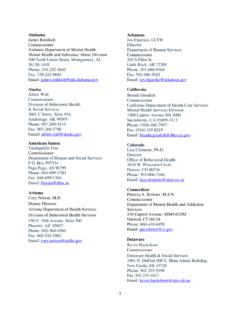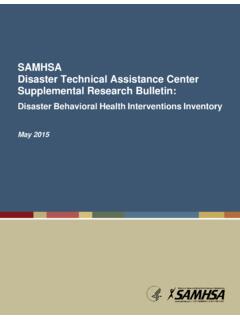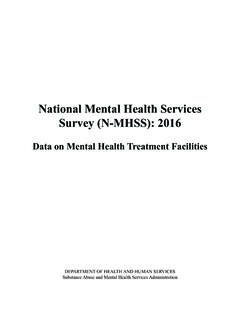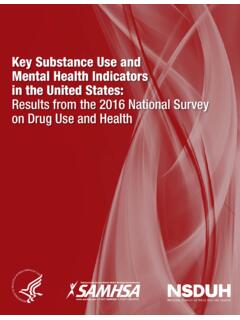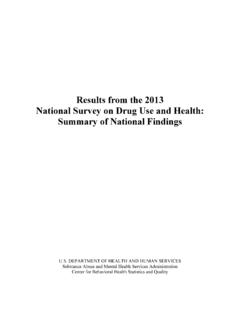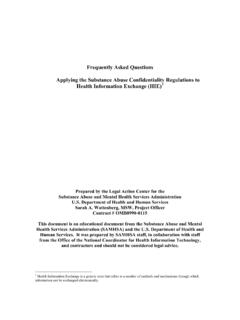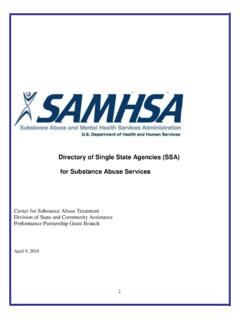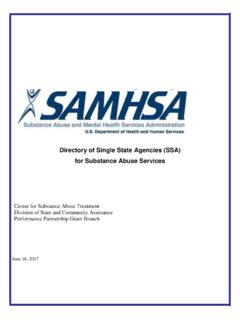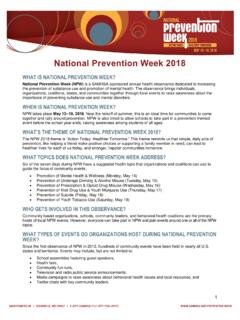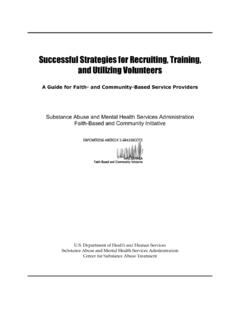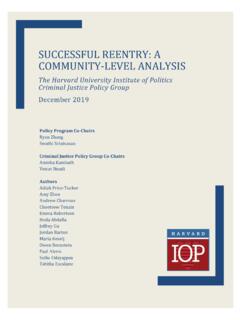Transcription of REENTRY RESOURCES FOR INDIVIDUALS, PROVIDERS, …
1 2 SAMHSA s mission is to reduce the impact of substance abuse and mental illness on America s communities. 1-877-SAMHSA-7 (1-877-726-4727) 1-800-486-4889 (TDD) KEY ISSUE: REENTRYREENTRY RESOURCES FOR INDIVIDUALS, PROVIDERS, COMMUNITIES, AND STATESLEARN ABOUT SAMHSA REENTRY RESOURCES FOR: Behavioral Health Providers & Criminal Justice Practitioners Individuals Returning From Jails & Prisons Communities & Local Jurisdictions State PolicymakersAT A GLANCEI ndividuals with mental and substance use disorders involved with the criminal justice system can face many obstacles accessing quality behavioral health service. For individuals with behavioral health issues reentering the community after incarceration, those obstacles include a lack of health care, job skills, education, and stable housing, and poor connection with community behavioral health providers. This may jeopardize their recovery and increase their probability of relapse and/or re-arrest. Additionally, individuals leaving correctional facilities often have lengthy waiting periods before attaining benefits and receiving services in the community.
2 Too often, many return to drug use, criminal behavior, or homelessness when these obstacles prevent access to needed services. The Office of National Drug Control Policy reports: More than 40% of offenders return to state prison within 3 years of their release. 75% of men and 83% of women returning to state prison report using illegal women returning to state prison report using illegal drugs compared to DATE health is essential to is RECOVER. s mission is to reduce the impact of substance abuse and mental illness on America s communities. 1-877-SAMHSA-7 (1-877-726-4727) 1-800-486-4889 (TDD) efforts to help meet the needs of individuals with mental and substance use disorders returning to the community, and the needs of the community include: Grant programs such as the Offender REENTRY Program (ORP) that expand and enhance substance use treatment services for individuals reintegrating into communities after being released from correctional facilities.
3 Actively partnering with other federal agencies to address the myriad of issues related to offender REENTRY through policy changes, recommendations to states and local governments, and elimination of myths surrounding offender REENTRY . Providing RESOURCES to individuals returning from jails and prisons, behavioral health providers and criminal justice practitioners, communities and local jurisdictions, and state policymakers. At federal, state and local levels, criminal justice reforms are changing the landscape of criminal justice policies and practices. In 2015, federal efforts focused on REENTRY services and supports for justice-involved individuals with mental and substance use disorders have driven an expansion of programs and services. REENTRY is a key issue in SAMHSA s Trauma and Justice Strategic Initiative. This strategic initiative addresses the behavioral health needs of people involved in - or at risk of involvement in - the criminal and juvenile justice systems.
4 Additionally, it provides a comprehensive public health approach to addressing trauma and establishing a trauma-informed approach in health, behavioral health, criminal justice, human services, and related RESOURCESThis key issue guide provides an inventory of SAMHSA RESOURCES for individuals returning from jails and prisons, behavioral health providers and criminal justice practitioners, communities and local jurisdictions, and FOR BEHAVIORAL HEALTH PROVIDERS AND CRIMINAL JUSTICE PRACTITIONERSGAINS REENTRY Checklist for Inmates Identified with Mental Health Needs (2005) This publication provides a checklist and template for identifying and implementing a successful REENTRY plan for individuals with mental and substance use Quick Guide for Clinicians: Continuity of Offender Treatment for Substance Use Disorder from Institution to Community Helps substance abuse treatment clinicians and case workers to assist offenders in the transition from the criminal justice system to life after release.
5 Discusses assessment, transition plans, important services, special populations, and confidentiality. Trauma Informed Response Training The GAINS Center has developed training for criminal justice professionals to raise awareness about trauma and its effects. How Being Trauma-Informed Improves Criminal Justice System Responses is a one-day training for criminal justice professionals to: Increase understanding and awareness of the impact of trauma Develop trauma-informed responses Provide strategies for developing and implementing trauma-informed policies2 SAMHSA s mission is to reduce the impact of substance abuse and mental illness on America s communities. 1-877-SAMHSA-7 (1-877-726-4727) 1-800-486-4889 (TDD) This highly interactive training is specifically tailored to community-based criminal justice professionals, including police officers, community corrections personnel, and court personnel. SOAR TA Center Provides technical assistance on SAMHSA s SSI/SSDI Outreach, Access and Recovery (SOAR), a national program designed to increase access to the disability income benefit programs administered by the Social Security Administration (SSA) for eligible adults who are experiencing or are at risk of homelessness and have a mental illness, medical impairment, and/or a co-occurring substance use disorder.
6 RESOURCES FOR INDIVIDUALS RETURNING FROM JAILS AND PRISONSSAMHSA s Behavioral Health Treatment Locator Search online for treatment facilities in the United States or Territories for substance abuse/addiction and/or mental health problems. Self-Advocacy and Empowerment Toolkit Find RESOURCES and strategies for achieving personal recovery goals. Obodo Find RESOURCES and information and make connections in your community. Users set up profiles, add photos, bookmark RESOURCES and interests, and can email other members. SecondChanceResources Library Find REENTRY RESOURCES and information. Right Path RESOURCES and information for persons formerly incarcerated, and the people who help them (parole officers, community service staff, family and friends). RESOURCES FOR COMMUNITIES AND LOCAL JURISDICTIONSE stablishing and Maintaining Medicaid Eligibility upon Release from Public Institutions This publication describes a model program in Oklahoma designed to ensure that eligible adults leaving correctional facilities and mental health institutions have Medicaid at discharge or soon thereafter.
7 Discusses program findings, barriers, and lessons learned. Providing a Continuum of Care and Improving Collaboration among Services This publication examines how systems of care for alcohol and drug addiction can collaborate to provide a continuum of care and comprehensive substance abuse treatment services. Discusses service coordination, case management, and treatment for co-occurring disorders. A Best Practice Approach to Community REENTRY from Jails for Inmates with Co-occurring Disorders: The APIC Model (2002) This publication provides an overview of the APIC Model, a set of critical elements that, if implemented, are likely to improve outcomes for persons with co-occurring disorders who are released from jail. 3 SAMHSA s mission is to reduce the impact of substance abuse and mental illness on America s communities. 1-877-SAMHSA-7 (1-877-726-4727) 1-800-486-4889 (TDD) for the Successful Transition of People with Behavioral Health Disorders from Jail and prison (2013) This publication presents guidelines that are intended to promote the behavioral health and criminal justice partnerships necessary to successfully identify which people need services, what services they need, and how to match these needs upon transition to community-based treatment and supervision.
8 Uploads/2013/12 s Offender REENTRY Program Using grant funding, the program encourages stakeholders to work together to give adult offenders with co-occurring substance use and mental health disorders the opportunity to improve their lives through recovery. the Gap: Improving the Health of Justice-Involved People through Information Technology This publication is a review of the proceedings from a two-day conference convened by SAMHSA in 2014. The meeting aimed to address the problems of disconnected justice and health systems and to develop solutions by describing barriers, benefits, and best practices for connecting community providers and correctional facilities using health information technology (HIT). FOR STATE POLICYMAKERSB ehavioral Health Treatment Needs Assessment for States Toolkit Provide states and other payers with information on the prevalence and use of behavioral health services; step-by-step instructions to generate projections of utilization under insurance expansions; and factors to consider when deciding the appropriate mix of behavioral health benefits, services, and providers to meet the needs of newly eligible populations.
9 Medicaid Coverage and Financing of Medications to Treat Alcohol and Opioid Use Disorders This publication presents information about Medicaid coverage of medication-assisted treatment for opioid and alcohol dependence. Covers treatment effectiveness and cost effectiveness as well as examples of innovative approaches in Vermont, Massachusetts, and Maryland. All publications are available free through SAMHSA s SAMHSA TOPICSA lcohol, Tobacco, and Other Drugs Behavioral Health Treatments and Services Criminal and Juvenile Justice Data, Outcomes, and Quality Disaster Preparedness, Response, and Recovery Health Care and Health Systems Integration Health Disparities Health Financing Health Information Technology HIV, AIDS, and Viral Hepatitis Homelessness and Housing Laws, Regulations, and Guidelines Mental and Substance Use Disorders Prescription Drug Misuse and Abuse Prevention of Substance Abuse and Mental Illness Recovery and Recovery Support School and Campus Health Specific Populations State and Local Government Partnerships Suicide Prevention Trauma and Violence Tribal Affairs Underage Drinking Veterans and Military Families Wellness Workforce4 SAMHSA s mission is to reduce the impact of substance abuse and mental illness on America s communities.
10 1-877-SAMHSA-7 (1-877-726-4727) 1-800-486-4889 (TDD)
